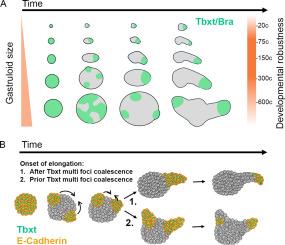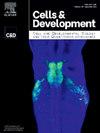Morphogenetic constraints in the development of gastruloids: Implications for mouse gastrulation
IF 2
4区 生物学
Q4 Biochemistry, Genetics and Molecular Biology
引用次数: 0
Abstract
Mammalian embryonic size is tightly controlled with checkpoints and compensatory mechanisms correcting size defects. Here, we take advantage of gastruloids, a stem cell embryoid system not subject to most size controls, to study the role of size in emergent properties of mammalian embryogenesis. We report that gastruloids exhibit robust morphology and transcriptional profiles within a size range. However, size affects the dynamics, and, outside a range of robust morphogenesis, the precision of anterior-posterior (AP) axial elongation. Gastruloid axial elongation exhibits active cellular contractility, requires planar cell polarity (PCP), adhesion and cell-cell contact remodelling. Smaller gastruloids initiate elongation earlier, correlated with an earlier Brachyury polarisation. Brachyury expression increases tissue fluidity. Axis formation is regulated by the balance of Brachyury multifoci coalescence and the timing of initiation of the elongation programme. Sizes beyond the robust range can modify relative tissue composition. Very small aggregates have increased neural fate bias, accompanied by a loss of paraxial mesoderm mediated by differences in Nodal signalling activity.

类原肠发育的形态发育限制:对小鼠原肠形成的影响
哺乳动物胚胎的大小受到检查点和补偿机制的严格控制。在这里,我们利用类原肠干细胞(一种不受大多数大小控制的干细胞胚胎系统)来研究大小在哺乳动物胚胎发生的涌现特性中的作用。我们报告说,胃样蛋白在大小范围内表现出强大的形态和转录谱。然而,大小影响动力学,并且,在稳健的形态发生范围之外,前后(AP)轴向伸长的精度。胃原体轴向伸长表现出活跃的细胞收缩性,需要平面细胞极性(PCP)、粘附和细胞-细胞接触重塑。较小的原肠样体较早开始伸长,这与较早的短胚轴极化有关。Brachyury的表达增加了组织流动性。轴的形成是由短叶鞘多焦点聚结的平衡和开始伸长计划的时间来调节的。超过鲁棒范围的尺寸可以改变相对组织组成。非常小的聚集体增加了神经命运偏差,伴随着由节信号活动差异介导的近轴中胚层的丧失。
本文章由计算机程序翻译,如有差异,请以英文原文为准。
求助全文
约1分钟内获得全文
求助全文
来源期刊

Cells and Development
Biochemistry, Genetics and Molecular Biology-Developmental Biology
CiteScore
2.90
自引率
0.00%
发文量
33
审稿时长
41 days
 求助内容:
求助内容: 应助结果提醒方式:
应助结果提醒方式:


